Menus
- BMW R 90 S, BSA Rocket 3, Ducati 750 SS and Kawasaki 900 Z1
- The first impression
- Seat rehearsal
- BMW R 90 S.
- BSA Rocket 3
- Ducati 750 SS
- Undercarriages
- Conclusion
- Technical specifications
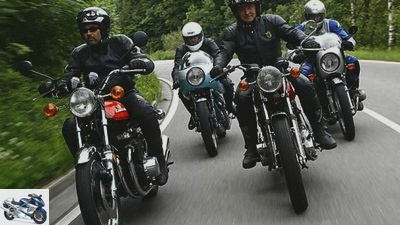
Jahn
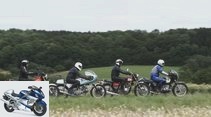
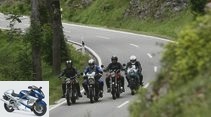
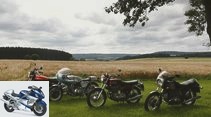
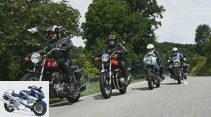
12th photos
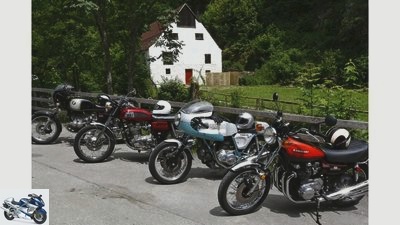
1/12
BMW R 90 S, BSA Rocket 3, Ducati 750 SS and Kawasaki 900 Z1 are ready to go.
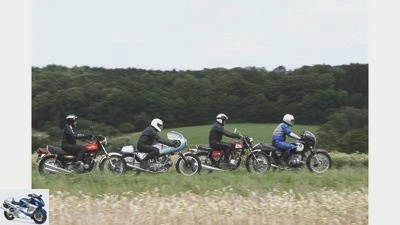
2/12
… Occasionally the oats sting. Werner "Mini" Koch at BSA sums it up: "The older we get, the faster we used to be."
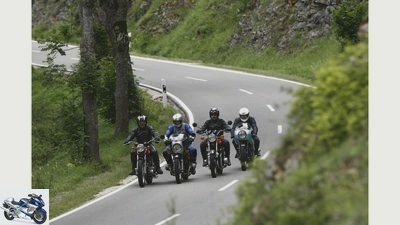
3/12
When the BMW R 90 S, BSA Rocket 3, Ducati 750 SS and Kawasaki 900 Z1 go on tour together, the old rivalries rest. The drivers, however …
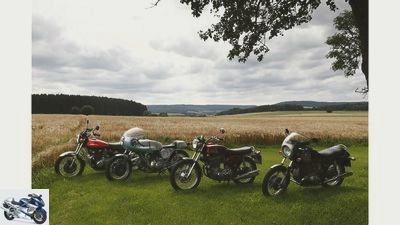
4/12
You don’t even have to ride the four motorcycles to get an idea of their philosophy: Even when they are stationary, they reveal a lot to the attentive observer.
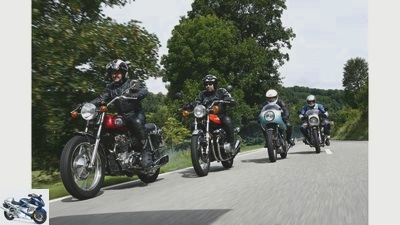
5/12
The BMW R 90 S holds back a little with 67 hp from 898 cc. Their strengths lie in driving comfort.
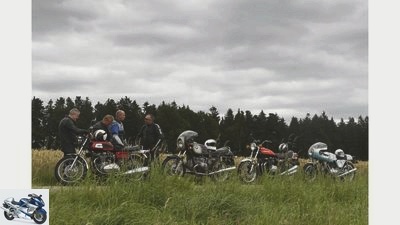
6/12
The vertical shaft V2 throws 72 hp with a 90-degree cylinder angle in the Ducati 750 SS (right).
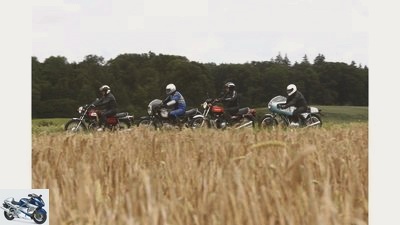
7/12
The three-cylinder bumper of the BSA Rocket 3 (left) has even been on the market since 1968. It makes 58 hp.
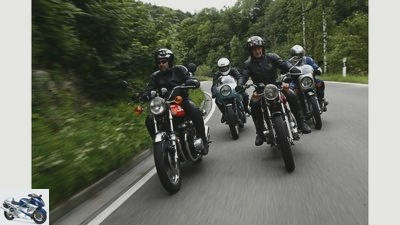
8/12
The dohc four-cylinder Kawasaki 900 Z1 (front) is the most powerful engine in the field with 82 hp.
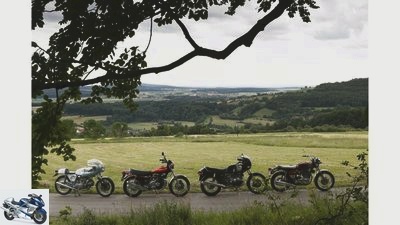
9/12
In 1974, five years after the appearance of the Honda CB 750, these motorcycles countered with their respective, but very different means.
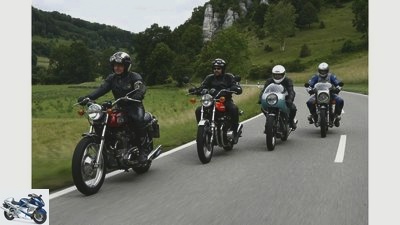
10/12
Different countries, different sitting: relaxed touristy on the BMW, typically English with footrests far in front of the BSA, sporty stretched on the Ducati and upright on the Kawasaki.
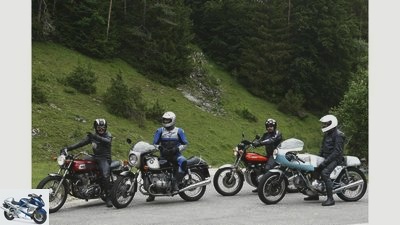
11/12
Do the top models of yore live up to their reputation, or does reality look different?
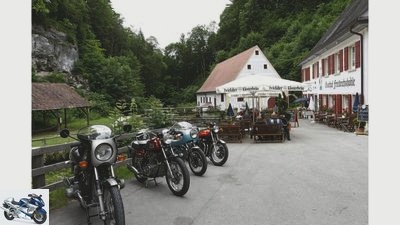
12/12
On the move with classics from the 1970s: BMW R 90 S, BSA Rocket 3, Ducati 750 SS and Kawasaki 900 Z1. Do the cliches from that time still apply??
Four classics on a trip together
BMW R 90 S, BSA Rocket 3, Ducati 750 SS and Kawasaki 900 Z1
Content of
Some things have always been crystal clear: touring German motorcycles, Japanese commuting, English oils and Italian sports. Basta.
E.Simple was the world at the beginning of the 1970s. Serving and cultivating cliches and using them to the point of excess has remained a popular form of pastime at the regulars’ tables around the world to this day. In the absence of personal experience, it was part of a dream to move exotic motorcycles at least mentally, to analyze them professionally and competently. If all the cliches were true, MOTORRAD CLASSIC could save itself a lot of work. But today, more than 30 years later, the question still arises: Will yesterday’s top models live up to their reputation, or does reality look different?
Buy complete article
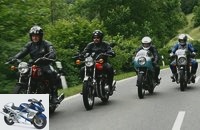
On the road with the BMW R 90 S, BSA Rocket 3, Ducati 750 SS, Kawasaki 900 Z1
Long live the cliche
Ducati hit the scene with the 750 SS: a super sports car derived from the V2 series. Imola’s aura grows around him like 100-year-old ivy, even before he has driven the first meter. The motorcycle seems to have turned straight off the racetrack onto the road and in the pit lane it seems to have noticed some everyday utensils en passant.
A lot has happened in the two-wheeled world in the Far East as well: In 1972 Kawasaki shocked the competition and electrified the performance-hungry clientele with the Kawasaki 900 Z1. With a nominal 82 hp from 903 cubic centimeters, it sets the bar high among mass-produced motorcycles. BMW also responded and in 1973 presented the R 90 S. In a sense, it opened up the tradition of the white-blue, which is still maintained today, of promising a super sports car and bringing a speedy tourer onto the market: with its 67 hp, the R 90 S cannot compete with the Kawasaki , but at least sets new standards within the BMW range. The English patients are already a bit gray and have been on the market since 1968: In the top segment, with the Triumph Trident and the BSA Rocket 3, the islanders trust the three-cylinder bumper. While BSA discontinued production in Birmingham in 1972, Triumph continued to manufacture the triplet in Coventry for a few years
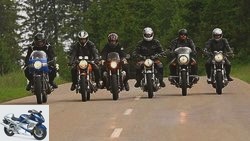
Tourer
On the move: classics of the 70s
Europe wheel
read more
The first impression
Said four are ready in a row in 2007, collector Jurgen Hoch generously donated them to MOTORRAD CLASSIC.
The BMW R 90 S.: as fresh as a dew, as if it had just left the factory in Berlin-Spandau. The BSA Rocket 3 as if it wanted to hide its real age: the exhaust system points to a model from 1970, the identical parts from Triumph and BSA, such as fork and brakes, to a later year of construction. In addition, the cylinder looks suspiciously like a retrofit part from the tuning industry. The Ducati 750 SS: crouched, as if waiting impatiently for the Le Mans start. She had to sacrifice part of her rear fender in her first life on the racetrack. The Kawasaki 900 Z1: brand new, as if it had just rolled out of the store of Detlev Louis, the importer at the time. It actually comes from the USA: the mileage speedometer, the short rear fender and the reflectors on the suspension struts document that it has already traveled across the Atlantic
Seat rehearsal
As if on announcement, the BSA uses the first cliche: It marks its location with a Castrol note and will leave its marks more frequently during the test. BMW also confirms its template. The seat sample is relaxed: hands compact on the narrow handlebars, legs moderately angled, the driver feels as comfortable as on a dignified, contemporary seat set – brown leather, rustic oak. The BSA is also relaxed, but in a completely different way, very British, namely. The hands are far apart on the wide handlebars, which are slightly bent at the ends. Also wide and relatively far forward, the feet rest on the rests, the lower legs as vertical as Miss Sophie at the birthday dinner.
The Ducati does not deny its ancestry either, only this is a completely different one: the classic racing posture stretches the upper body over the long tank, the legs on the high pegs are strongly angled. Thanks to the plexiglass dome, almost every meter of asphalt looks like a racetrack. But the Italian doesn’t suit everyone’s taste, she divides the opinion of the test crew. The ergonomics managers at Kawasaki could not make a clear decision. Quite apart from the wide handlebar – it is identical for the US and European versions – the Z1 positions the rider pseudo-touristically on the motorcycle: the upper body upright, the legs slightly bent.
The testers are waiting impatiently for the start. This is also very different, spontaneous at BMW and Kawasaki: pull the choke, press the starter button, both start immediately, but need a few kilometers until their engines smoothly accelerate without choke and run smoothly. More tedious with the Ducati: Even with the Dell’Ortos flooded, she wants to be persuaded with many kicks, but once warmed up, she always jumps at the first kick. Downright epic at the BSA: At first, it strikes against the iron Kickstarter like English miners against Maggie Thatcher. Only courageous pushing encourages them to serve.
BMW R 90 S.
Jahn
BMW R 90 S..
The colleague on the cliched reliable BMW has meanwhile set off and experienced – a BMW: without surprises, ups and downs. The boxer pulls through evenly from medium engine speeds and only appears strenuous in higher regions. Turning out to the red area has no advantages. The vibrations are kept within limits. And the music? The motor hums moderately through the scale. The transmission also shifts in typical BMW fashion: unsteady with long distances.
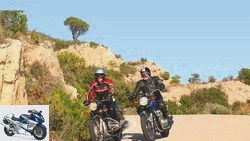
motorcycles
On the move: BMW R 75/5, Honda CB 750
The summer of 69
read more
BSA Rocket 3
BSA Rocket 3.
The triplet of the BSA is far less conformist. Once warmed up, it surprises with pulling power: From the very bottom it pushes forward with vigor and outclasses the three competitors with British composure. In doing so, he applies so much torque to the clutch that it begins to slip. Judging by the marks on the numerous seams on the engine housing, the dry clutch has probably already overflowed to the oil bath fraction.
From 5000 rpm, the thrust decreases noticeably, shifting is opportune – with force, but then short, crisp and above all right, with first gear down. Just like the thrust, the sound is impressive: The three-cylinder chatters like a small eight-cylinder in the lower speed range and then goes over to the bassy tubes up to the dull howl that only distinguishes an in-line three-cylinder with a 120 degree crank pin offset. The jury duly honored the interpreter from the island: Royaume-Uni – douze points.
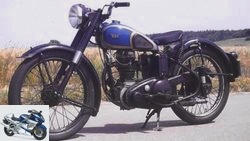
classic
On the move: BSA C11 de Luxe
For the sake of simplicity
read more
Ducati 750 SS
Jahn
Ducati 750 SS.
In this discipline, the Ducati has a say: The upright shaft V2 with the desmodromic valves breathes in unfiltered through the open Dell’Ortos and exhales again through the Conti bags. The 90-degree V2 throws its staccato fortissimo like Luciano Pavarotti into the group. The asymmetrical firing order also plays the Concerto Grosso that is still so typical of Ducati today.
The engine supports the ensemble to the best of its ability: from around 3000 rpm, it kicks off in order to strive steadily towards the red area with powerful thrust. The vibrations are kept within narrow limits. Today it looks far less like a racing engine, which the sound suggests, much more like a sporty all-round engine. Turning it out to the red area only enhances the acoustic performance. Rethinking when shifting: on the right as with the BSA, but first gear up, all others down. The clutch requires manual strength, curves require physical effort.
Vertical shaft: Ducati 750 SS
read more
Jahn
Kawasaki 900 Z1.
The Kawasaki keeps the pilot at a respectful distance by virtue of her stature: it stands there as massive as a sumo wrestler. The mighty inline four-cylinder with the two overhead camshafts and the imposing four-in-four exhaust system underline the overall picture. But the Kawasaki is actually far less aloof than it appears: the engine whispers quietly while idling. Pull the smooth clutch, sort the equally smooth gear, and the Kawa is civilized.
With properly usable performance from 3000 rpm, it pulls through strongly, but cannot hold a candle to the BSA. The second wind only blows from 5000 rpm, then the Kawasaki four-man can do something else: grunting aggressively from the four exhaust bags, it turns up with impressive aggressiveness. There is no question that the Japanese has the sportiest engine among the four competitors. The sound spectrum fits this characteristic, with a hoarse hissing sound reminiscent of the Grand Prix four-cylinder from Honda from the 60s, even if they cheered a few pitches higher. Not only nominally, but also subjectively, it leaves the most potent impression by far, even though it carries the most weight with a full tank of 247 kg.
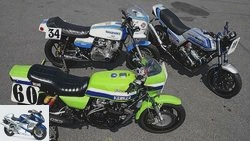
classic
On the move: AMA superbike replicas
Honda CB 1124 F, Kawasaki Z 1075 S, Suzuki GS 1000 S.
read more
Undercarriages
Jahn
Tilting saddles are now considered outdated technology, but they work great on the BMW R 90 S..
How do the undercarriages, which were often scolded in the 1970s, cope with the performance? The BMW gets along just fine with the 67 hp boxer. The comfortably coordinated spring elements swallow the worst bumps cleanly. Even the driving stability is decent, even if there is a slight, uncritical tendency to oscillate at higher speeds.
The handiness is exemplary: Despite the narrow handlebars, the boxer easily folds from one lean angle to the next, and sometimes feels almost nervous for novices. They also have to get used to the typical BMW load change reactions of the lengthways crankshaft and cardan drive: tilting around the longitudinal axis, setting up the swing arm. The brakes can still convince today. The system with the master brake cylinder under the tank and the double disc brake with the swiveling calipers decelerates appropriately with moderate manual force.
That cannot be said of the BSA’s conical duplex drum; like the British Empire, it must have seen better days. Even with iron hand strength, the delay can only be guessed at. Under heavy use, even fading occurs, the braking power then tends to zero, although the lever is already on the handlebars. The decelerator in the rear wheel doesn’t really help. To save my honor it should be said that the Triumph Trident has had a disc brake since 1973, which works better.
The rear suspension struts, which undoubtedly once had damping, act in a similar way to the brakes: as with barrel-aged whiskey, the shines over the years "angels’ share", the part of the angels being diffused out. The oil has left its place of work; The stern swings happily over bumps. Nevertheless, the BSA drives reasonably stable and is even relatively handy thanks to the wide handlebars and the moderate weight of 223 kilograms.
Handiness is not the Ducati’s showcase discipline, rather it is known for its much-cited and praised stability. Although the fork is less responsive than the components of the competition, the chassis still demonstrates leadership qualities. Undeterred by bumps or bad road surfaces, it pulls its course straight ahead as in curves up to the highest speeds.
The brakes support driving pleasure: the two cast discs with the Lockheed fixed calipers even surpass the BMW system. When it comes to chassis, the prima ballerina from Bologna is dancing around the competition.
Of course, the Kawasaki too. However, the Japanese four-cylinder does not adhere to the prejudice of the pendulum clock – certainly also thanks to modern tires. At best, speedy curves with bumps stimulate the chassis to move slightly on its own.
On the other hand, the American version amazes with a property that is not known from the European version: the original struts are extremely comfortable, downright soft. Thanks to the protruding handlebar, the handiness is acceptable measured at 247 kilograms. This also applies to the individual disc brakes in the front wheel, which demand pressure on the hand lever, but then decelerate properly.
Conclusion
Jahn
BSA Rocket 3, BMW R 90 S, Kawasaki 900 Z1, Ducati 750 SS
So what is left of the stubbornly circulating cliches that have been widespread at round tables for decades? The BMW lives up to the prejudice of the solid tourer in a positive sense. It works inconspicuously in all criteria without ups and downs. That’s why two of the four test drivers find them boring. Sit on it, feel good, drive off, even aim for distant destinations without worrying about the breakdown service – no problem. Rationally perhaps the winner, emotionally second division.
The BSA, yes, it oils, loses a droplet here and there, and if the contents of the oil tank of the dry sump lubrication has poured completely into the crankcase after a long time, it can be a pint. And otherwise? By today’s standards, she would be something like a power cruiser. Start, step through all four gears, then let yourself drift on the wave of torque and listen to the incomparable sound of the three-cylinder. So the ride on the BSA becomes a special kind of event. It is impossible to imagine if it also had brakes! Undoubtedly an impressive experience emotionally, a real challenge rationally.
The excellent chassis and the sporty seating position of the Ducati repeatedly demand one thing from the driver: più rapido, forza Italia, courageous grip, the Ducati fly. The aura of Paul Smart and Mike Hailwood is always there. Athletes love the driving machine from Bologna, tourists not. Fascination for purists.
The Kawasaki convinces with its powerful, sporty four-cylinder and its inimitable sound, which evokes the glamorous racing atmosphere of Japanese multi-cylinders from days gone by. The pseudo-tourist seating position doesn’t want to match the sporty demands of the engine, but it doesn’t matter at the showdown in front of the ice cream parlor. Thanks to modern tires, the once hot topic of commuting has cooled down a lot today. Show your muscles and let them play, the Z1 is the unconditional macho in a quartet.
So what to do with the cliches – frame or ignore? They partially refute rational feelings, they even stir up emotions and fascination, but that doesn’t have to be negative, on the contrary: Long live the cliche!
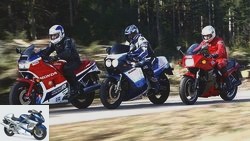
classic
On the move: Honda VF 1000 R, Kawasaki GP Z 900 R, Suzuki GSX-R 1100
Technical revolution
read more
Technical specifications
Jahn
BMW R 90 S..
BMW R 90 S.
Engine: Air-cooled two-cylinder four-stroke boxer engine, two valves each, operated by a camshaft below, bumpers and rocker arms, bore x stroke 90 x 70.6 mm, 898 cm³, 67 hp at 7000 rpm
Power transmission: Single-disc dry clutch, five-speed gearbox, cardan drive
Landing gear: Double loop frame made of tubular steel, telescopic fork in front; Ø 36 mm, two-arm swing arm made of tubular steel, two spring struts, spoked wheels with aluminum rims, tires, 3.25 H 19 front, 4.00 H 18 rear, double disc brake front, Ø 256 mm, single-piston swivel calipers, drum brake rear
Mass and weight: Wheelbase 1445 mm, weight 226 kg with a full tank
Driving performance: Top speed 200 km / h
Manufacturer: BMW AG, Munich
Jahn
BSA Rocket 3.
BSA Rocket 3
Engine: Air-cooled three-cylinder four-stroke in-line engine, two valves each, operated via two camshafts, bumpers and rocker arms, bore x stroke 67 x 70 mm, 740 cm³, 58 hp at 7500 rpm
Power transmission: Multi-disc dry clutch, four-speed gearbox, chain
Landing gear: Double loop frame made of tubular steel, telescopic fork, Ø 34.8 mm, two-arm swing arm made of tubular steel, suspension struts, spoke wheels, tires, 4.10 H 19 front, 4.25 / 85 H 18 rear, duplex drum brake front, Ø 203 mm, simplex drum brake rear, Ø 177 mm
Mass and weight: Wheelbase 1450 mm, weight 223 kg with a full tank
Driving performance: Top speed 190 km / h,
Manufacturer: BSA Motorcycles Ltd., Birmingham, England
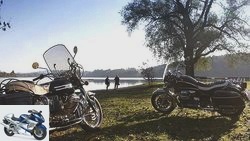
Tourer
On the move: Moto Guzzi California and California Vintage
California Dreams
read more
Jahn
Ducati 750 SS.
Ducati 750 SS
Engine: Air-cooled two-cylinder four-stroke 90-degree V-engine, two valves each, operated desmodromically by an overhead camshaft and rocker arm, bore x stroke 80 x 74.4 mm, 748 cm³, power 72 hp at 8000 / min
Power transmission: Multi-disc oil bath clutch, five-speed gearbox, chain
Landing gear: Backbone frame made of tubular steel, telescopic fork at the front, Ø 38 mm, two-arm swing arm, two spring struts, wire-spoke wheels with aluminum high-shoulder rims, tires 3.50-18 at the front, 4.00 at the rear, double disc brake at the front, Ø 280 mm, two-piston fixed calipers, disc brake at the rear, Ø 230 mm, two-piston fixed caliper
Mass and weight: Wheelbase 1480 mm, weight 210 kg with a full tank
Driving performance: Top speed 220 km / h
Manufacturer: Ducati S. p. A., Bologna
Jahn
Kawasaki 900 Z1.
Kawasaki 900 Z1
Engine: Air-cooled four-cylinder four-stroke in-line engine, two valves each, operated by two overhead camshafts and bucket tappets, bore x stroke 66 x 66 mm, 903 cm³, power
82 hp at 8500 rpm
Power transmission: Multi-disc oil bath clutch, five-speed gearbox, chain
Landing gear: Double loop frame made of tubular steel, telescopic fork Ø 36 mm, two-arm swing arm made of tubular steel, two spring struts, spoked wheels, tires 3.25 H 19 at the front, 4.00 H 18 at the rear, single disc brake at the front, Ø 296 mm, single-piston floating caliper, drum brake at the rear, 200 mm
Mass and weight: Wheelbase 1490 mm, weight fully fueled 247 kg
Driving performance: Top speed 220 km / h
Manufacturer: Kawasaki Heavy Industries Ltd., Akashi, Japan
Related articles
-
Comparison test: super sports cars under 1000 cubic meters from MV Agusta, Ducati and Kawasaki
Jahn 46 pictures Jahn 1/46 Kawasaki ZX-6R 636 Jahn 2/46 But the Evo is not alone in this. All three bikes rock the ring during the test. Jahn 3/46 ……
-
Ducati Multistrada 1200, Kawasaki Versys 1000 and Triumph Tiger 1050 in the test
Gargolov Funbikes in comparison test Ducati Multistrada 1200, Kawasaki Versys 1000 and Triumph Tiger 1050 With bag and pack on a big tour or simply …
-
Ducati Monster 821 and Kawasaki Z 800 in comparison test
Bilski 34 pictures Bilski 1/34 Kawasaki Z 800. Bilski 2/34 Ducati Monster 821 and Kawasaki Z 800 in the comparison test. Bilski 3/34 Ducati Monster 821 and …
-
Ducati 1299 Panigale S and Kawasaki Ninja H2 in comparison test
31 pictures 1/31 Left in the picture 197 HP and 145 Nm (Ducati 1299 Panigale S), on the right there are 200 HP and 133 Nm (Kawasaki Ninja H2) ….
-
Yamaha MT-07, Kawasaki ER-6, Suzuki Gladius 650 and Ducati Monster in the test
Jahn 39 pictures Jahn 1/39 Where I am is in front – the MT-07 is addicted to curves. Jahn 2/39 Less saved: At least the fork can be …
-
Comparison test Aprilia, Ducati, Kawasaki, KTM and Triumph
Artist comparison test Aprilia, Ducati, Kawasaki, KTM and Triumph Cool naked bikes Minimalistic, aggressive, greedy and cool ?? Focusing on naked bikes …
-
Presentation of the Kawasaki Versys, KTM innovations
Kawasaki presentation of the Kawasaki Versys, KTM innovations K it’s turn today Kawasaki and KTM: The two manufacturers with the K are refreshing the innovations scene ….
-
Triumph Rocket III in the driving report: more and less
Triumph 9 pictures Triumph 1/9 Even more displacement and Newton meters, but at the same time the weight screwed down. Does not sound bad. Triumph 2/9 …
-
Comparison test: Honda CX 500-650 Turbo, Kawasaki Z 750 Turbo, Suzuki XN 85, Yamaha XJ 650 Turbo
Jahn 21 pictures Jahn 1/21 The preload of the central spring strut of the Suzuki can be easily adjusted. Jahn 2/21 Tight corners and fast …
-
Driving report Kawasaki Ninja 400 (2018)
Arturo Rivas 29 photos Arturo Rivas 1/29 Kawasaki has redesigned the entry-level ninja. The twin’s cubic capacity and power increased, which is now…